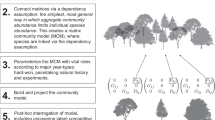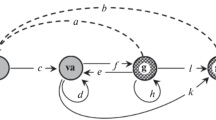Abstract
Matrix models are widely used in biology to predict the temporal evolution of stage-structured populations. One issue related to matrix models that is often disregarded is the sampling variability. As the sample used to estimate the vital rates of the models are of finite size, a sampling error is attached to parameter estimation, which has in turn repercussions on all the predictions of the model. In this study, we address the question of building confidence bounds around the predictions of matrix models due to sampling variability. We focus on a density-dependent Usher model, the maximum likelihood estimator of parameters, and the predicted stationary stage vector. The asymptotic distribution of the stationary stage vector is specified, assuming that the parameters of the model remain in a set of the parameter space where the model admits one unique equilibrium point. Tests for density-dependence are also incidentally provided. The model is applied to a tropical rain forest in French Guiana.


Similar content being viewed by others
References
Alvarez-Buylla ER, Slatkin M (1991) Finding confidence limits on population growth rates. Trends Ecol Evol 6(7):221–224
Alvarez-Buylla ER, Slatkin M (1993) Finding confidence limits on population growth rates: Monte Carlo test of a simple analytic method. Oikos 68:273–282
Alvarez-Buylla ER, Slatkin M (1994) Finding confidence limits on population growth rates: three real examples revised. Ecology 75(1):255–260
Alvarez-Buylla ER, García-Barrios R, Lara-Moreno C, Martínez-Ramos M (1996) Demographic and genetic models in conservation biology: applications and perpectives for tropical rain forest tree species. Annu Rev Ecol Syst 27:387–421
Boscolo M, Vincent JR (1998) Promoting better logging practices in tropical forests: a simulation analysis of alternative regulations. Development Discussion Paper 652, The Harvard Institute for International Development, Harvard University, Cambridge, Massachusetts, USA
Boyce MS (1992) Population viability analysis. Annu Rev Ecol Syst 23:481–506
Bozdogan H (1987) Model selection and Akaike’s information criterion (AIC): the general theory and its analytical extensions. Psychometrika 52(3):345–370
Buongiorno J, Gilless JK (2003) Decision methods for forest resource management. Academic Press, Amsterdam
Buongiorno J, Dahir S, Lu HC, Lin CR (1994) Tree size diversity and economic returns in uneven-aged forest stands. For Sci 40(1):83–103
Buongiorno J, Peyron JL, Houllier F, Bruciamacchie M (1995) Growth and management of mixed-species, uneven-aged forests in the French Jura: implications for economic returns and tree diversity. For Sci 41(3):397–429
Caswell H (2001) Matrix population models: construction, analysis and interpretation, 2nd edn. Sinauer Associates, Inc Publishers, Sunderland
Cuevas A, Romo J (1995) On the estimation of the influence curve. Can J Stat 23(1):1–9
da Fonseca Cancela JP, Hadjibiros K (1977) Le modèle matriciel déterministe de Leslie et ses applications en dynamique des populations. Acta Biotheor 26(4):239–261
Doubleday WG (1975) Harvesting in matrix population models. Biometrics 31(1):189–200
Favrichon V (1998) Modeling the dynamics and species composition of tropical mixed-species uneven-aged natural forest: effects of alternative cutting regimes. For Sci 44(1):113–124
Fieberg J, Ellner SP (2001) Stochastic matrix models for conservation and management: a comparative review of methods. Ecol Lett 4(3):244–266
Gourlet-Fleury S, Guehl JM, Laroussinie O (eds) (2004) Ecology and management of a neotropical rainforest. Lessons drawn from Paracou, a long-term experimental research site in French Guiana. Elsevier, Paris
Gross K, Morris WF, Wolosin MS, Doak DF (2006) Modeling vital rates improves estimation of population projection matrices. Popul Ecol 48(1):79–89
Hampel FR (1974) The influence curve and its role in robust estimation. J Am Stat Assoc 69:383–393
Hauser CE, Cooch EG, Lebreton JD (2006) Control of structured populations by harvest. Ecol Modell 196(3–4):462–470
Houllier F, Lebreton JD, Pontier D (1989) Sampling properties of the asymptotic behavior of age- or stage-grouped population models. Math Biosci 95(2):161–177
Ingram D, Buongiorno J (1996) Income and diversity tradeoffs from management of mixed lowland dipterocarps in Malaysia. J Trop For Sci 9(2):242–270
Jarry M, Khaladi M, Hossaert-McKey M, McKey D (1995) Modeling the population dynamics of annual plants with seed bank and density dependent effects. Acta Biotheor 43(1–2):53–65
Jarry M, Davaine P, Beall E (1998) A matrix model to study the colonization by brown trout of a virgin ecosystem in the Kerguelen islands. Acta Biotheor 46(3):253–272
Jiang L, Shao N (2004) Red environmental noise and the appearance of delayed density dependence in age-structured populations. Proc R Soc Lond B 271(1543):1059–1064
Kaye TN, Pyke DA (2003) The effect of stochastic technique on estimates of population viability from transition matrix models. Ecology 84(6):1464–1476
Keyfitz N (1967) Reconciliation of population models: matrix, integral equation and partial fraction. J R Stat Soc A 130:61–83
Klok C, Holtkamp R, van Apeldoorn R, Visser ME, Hemerik L (2006) Analysing population numbers of the house sparrow in The Netherlands with a matrix model and suggestions for conservation measures. Acta Biotheor 54(3):161–178
Lande R (1993) Risks of population extinction from demographic and environmental stochasticity and random catastrophes. Am Nat 142:911–927
Lefkovitch LP (1965) The study of population growth in organisms grouped by stages. Biometrics 21:1–18
Leslie PH (1945) In the use of matrices in certain population mathematics. Biometrika 33:183–212
Liang J, Buongiorno J, Monserud RA (2005) Growth and yield of all-aged douglas-fir – western hemlock forest stands: a matrix model with stand diversity effects. Can J For Res 35(10):2368–2381
Lin CR, Buongiorno J, Vasievich M (1996) A multi-species, density-dependent matrix growth model to predict tree diversity and income in northern hardwood stands. Ecol Modell 91(1–3):193–211
Liquet B (2002) Sélection de modèles semi-paramétriques. Thèse de doctorat, Université Victor Segalien–Bordeaux 2, Bordeaux
Lu HC, Buongiorno J (1993) Long- and short-term effects of alternative cutting regimes on economic returns and ecological diversity in mixed-species forests. For Ecol Manage 58(3–4):173–192
Menges ES (2000) Population viability analyses in plants: challenges and opportunities. Trends Ecol Evol 15(2):51–56
Michie BR, Buongiorno J (1984) Estimation of a matrix model of forest growth from re-measured permanent plots. For Ecol Manage 8:127–135
Morris WF, Doak DF (2002) Quantitative conservation biology: theory and practice of population viability analysis. Sinauer Associates Inc., Sunderland
Nelder JA, Mead R (1965) A simplex algorithm for function minimization. Comput J 7:308–313
Neubert MG, Caswell H (2000) Demography and dispersal: calculation and sensitivity analysis of invasion speed for structured populations. Ecology 81(6):1613–1628
Ramula S, Lehtilä K (2005) Importance of correlations among matrix entries in stochastic models in relation to number of transition matrices. Oikos 111(1):9–18
Rogers-Bennett L, Rogers DW (2006) A semi-empirical growth estimation method for matrix models of endangered species. Ecol Modell 195(3–4):237–246
Rollin F, Buongiorno J, Zhou M, Peyron JL (2005) Management of mixed-species, uneven-aged forests in the French Jura: from stochastic growth and price models to decision tables. For Sci 51(1):64–75
Solomon DS, Hosmer RA, Hayslett HT (1986) A two-stage matrix model for predicting growth of forest stands in the Northeast. Can J For Res 16:521–528
Taylor BL (1995) The reliability of using population viability analysis for risk classification of species. Conserv Biol 9(3):551–558
Usher MB (1966) A matrix approach to the management of renewable resources, with special reference to the selection forests. J Appl Ecol 3:355–367
Usher MB (1969) A matrix model for forest management. Biometrics 25(2):309–315
van Groenendael J, de Kroon H, Caswell H (1988) Projection matrices in population biology. Trends Ecol Evol 3(10):264–269
Vanclay JK (1995) Growth models for tropical forests: a synthesis of models and methods. For Sci 41(1):7–42
Zetlaoui M, Picard N, Bar-Hen A (2006) Asymptotic distribution of stage-grouped population models. Math Biosci 200(1):76–89
Zetlaoui M, Picard N, Bar-hen A (2007) Robustness of the estimators of transition rates for stage-classified matrix models. Comput Stat Data Anal 51(10):5090–5102
Zhou M, Buongiorno J (2004) Nonlinearity and noise interaction in a model of forest growth. Ecol Modell 180(2–3):291–304
Author information
Authors and Affiliations
Corresponding author
Appendices
Appendix A: Differential of the Application \(\theta\mapsto{\mathbf{N}}_{\infty}\)
Assuming that it is an application, h maps the vector of parameters θ onto the asymptotic stage distribution \({\mathbf N}_{\infty}.\) We hereafter focus on the simplified model (3). Thus, \(h:{\mathbf R}^{10}\rightarrow{\mathbf R}^m,\) and the differential dθ h is a m × 10 matrix whose element on the ith row and jth column is \(\partial N_i/\partial\theta_j,\) where N i is the ith element of \({\mathbf N}_{\infty}\) and θ j is the jth element of θ. The function h is implicitly defined as Φ[h(θ),θ] = 0 where \(\Phi:{\mathbf R}^{m}\times{\mathbf R}^{10}\rightarrow{\mathbf R}^{m}\) is given by (4). Let Φ i be the ith element of Φ (1 ≤ i ≤ m), let dθΦ be the partial differential of Φ represented by the m × 10 matrix \((\partial\Phi_i/\partial\theta_j)_{1\leq i\leq m,1\leq j\leq 10},\) and let \(\hbox{d}_{\mathbf N}\Phi\) be the partial differential of Φ represented by the m × m matrix \((\partial\Phi_i/\partial N_j)_{1\leq i,j\leq m}.\) Then, by the implicit function theorem,
We are now left with computing the partial derivatives of Φ.
For the simplified model (3) and \(\forall i,j,\)
where a j is the jth element of a. Using the developed form of the matrix relationship,
The partial derivatives of Φ with respect to \({\mathbf N}\) are thus:
-
for the first element of Φ,
$$ \frac{\partial\Phi_1}{\partial N_j}=\left\{ \begin{array}{lr} 1-p_1+\xi a_1p_1N_1+\beta a_1f\sum_{k=1}^mN_k-f & (j=1)\\ \xi a_jp_1N_1+\beta a_jf\sum_{k=1}^mN_k-f &(2\leq j\leq m) \end{array} \right. $$ -
for 2 ≤ i ≤ m,
$$ \frac{\partial\Phi_i}{\partial N_j}=\left\{ \begin{array}{lr} 1-p_i+\xi a_ip_iN_i+\kappa a_iq_{i-1}N_{i-1} & (j=i)\\ -q_{i-1}+\xi a_{i-1}p_iN_i+\kappa a_{i-1}q_{i-1}N_{i-1} & (j=i-1)\\ \xi a_jp_iN_i+\kappa a_jq_{i-1}N_{i-1} & (j\neq i,i-1) \end{array} \right. $$
Moreover, given that the parameters are in the order θ = (μ0, μ1, μ2, ξ, ν0, ν1, ν2, κ, α, β), the partial derivatives of Φ with respect to θ are:
-
for 1 ≤ j ≤ 4,
$$ \frac{\partial\Phi_i}{\partial\theta_j}= -\frac{\partial p_i}{\partial\theta_j}N_i\quad(1\leq i\leq m) $$ -
for 5 ≤ j ≤ 8,
$$ \frac{\partial\Phi_i}{\partial\theta_j}=\left\{ \begin{array}{lr} 0 & (i=1)\\ -(\partial q_{i-1}/\partial\theta_j)N_{i-1} & (2\leq i\leq m) \end{array} \right. $$ -
for j = 9, 10,
$$ \frac{\partial\Phi_i}{\partial\theta_j}=\left\{ \begin{array}{lr} -(\partial f/\partial\theta_j)\sum_{k=1}^mN_k & (i=1)\\ 0 & (2\leq i\leq m) \end{array} \right. $$
where the partial derivatives of the vital rates with respect to the parameters θ are:
Finally, to compute the differential of h at θ it is necessary to compute \({\mathbf N}_{\infty}=h(\theta),\) that is to say to solve \(\Phi({\mathbf N},\theta)=0\) for N. To this end, we used the numerical method proposed by Caswell (2001, Sect. 16.2.1 p. 518).
Appendix B: Fisher Information Matrix of θ
Computations are done for the simplified model (3). The 10 parameters are taken in the order θ = (μ0, μ1, μ2, ξ, ν0, ν1, ν2, κ, α, β). The Fisher information matrix I(θ) for a sample of size one is a 10 × 10 matrix with element:
where ℓθ is given by (7) and the expectation is over the distribution (5) of the observation X. As the estimators of α and β are independent from the other parameters, I(θ) is actually of the form: where \(\theta^{\ast}\) is the restriction of θ to the eight first parameters. The logarithm of ℓθ is:
where \(\theta^{\ast}\) is the restriction of θ to the eight first parameters. The logarithm of ℓθ is:
where the small dot denotes any stage (including 0), the big dot denotes any stage except 0 and, by convention, q mk = 0. The partial derivatives of ln ℓθ with respect to θ then are:
where, using (6),
and the partial derivatives of the vital rates with respect to the parameters θ are given in Appendix A. The non-null elements of the Fisher information matrix then are:
-
for 1 ≤ j,l ≤ 4,
$$ [I(\theta)]_{jl}=\sum_{i=1}^m\sum_{k=1}^K\frac{\partial p_{ik}}{\partial\theta_j}\frac{\partial p_{ik}}{\partial\theta_l} \rho_k(1-f_k^{\ast})d_{ik}\left(\frac{1}{p_{ik}}+\frac{1}{1-p_{ik}-q_{ik}} \right) $$ -
for 5 ≤ j,l ≤ 8,
$$ [I(\theta)]_{jl}=\sum_{i=1}^{m-1}\sum_{k=1}^K\frac{\partial q_{ik}}{\partial\theta_j}\frac{\partial q_{ik}}{\partial\theta_l} \rho_k(1-f_k^{\ast})d_{ik}\left(\frac{1}{q_{ik}}+\frac{1}{1-p_{ik}-q_{ik}} \right) $$ -
for 1 ≤ j ≤ 4 and 5 ≤ l ≤ 8,
$$ [I(\theta)]_{jl}=[I(\theta)]_{lj}=\sum_{i=1}^m\sum_{k=1}^K\frac{\partial p_{ik}}{\partial\theta_j}\frac{\partial q_{ik}}{\partial\theta_l} \rho_k(1-f_k^{\ast})d_{ik}\frac{1}{1-p_{ik}-q_{ik}} $$ -
for 9 ≤ j,l ≤ 10,
$$ \begin{aligned} {[I(\theta)]_{9,9}} &= \frac{1}{\alpha^2}\sum_{k=1}^K\rho_k\frac{f_k}{(1+f_k)^2}, \quad [I(\theta)]_{10,10}=\sum_{k=1}^K\rho_k({\mathbf{N}}_k.{\mathbf{a}})^2 \frac{f_k}{(1+f_k)^2},\\ {[I(\theta)]_{9,10}} &= [I(\theta)]_{10,9}=-\frac{1}{\alpha}\sum_{k=1}^K\rho_k({\mathbf{N}}_k.{\mathbf{a}}) \frac{f_k}{(1+f_k)^2} \end{aligned} $$
Rights and permissions
About this article
Cite this article
Zetlaoui, M., Picard, N. & Bar-Hen, A. Asymptotic Distribution of Density-Dependent Stage-Grouped Population Dynamics Models. Acta Biotheor 56, 137–155 (2008). https://doi.org/10.1007/s10441-008-9034-0
Received:
Accepted:
Published:
Issue Date:
DOI: https://doi.org/10.1007/s10441-008-9034-0




